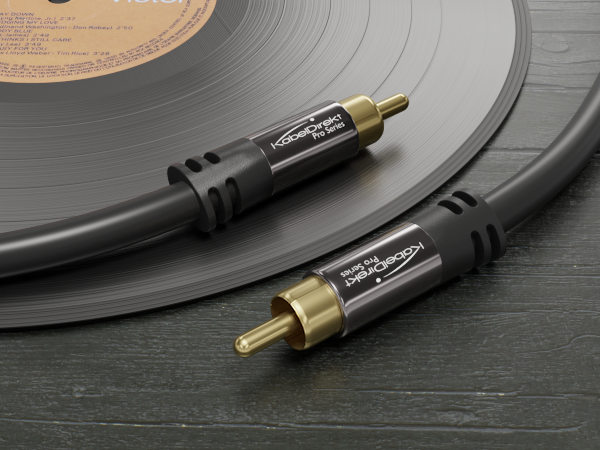
RCA/PHONO CABLES FOR AUDIO & VIDEO: ALL YOU NEED TO KNOW
Share

RCA/phono cables can carry both audio and video signals. But what are all those different connectors about, and where do you use them? Read on to learn all you need to know about RCA/phono cables.
RCA/phono cables have been around for an eternity, with the Radio Corporation of America (RCA) developing the technology way back in the 1930s. This makes it all the more surprising that they’re still in use today. After all, a lot has happened in the field of audio and video transmission technology in recent decades, which is why there are now several more modern alternatives – first and foremost HDMI. But the RCA/phono cable is still going strong.
There are two types of RCA/phono cable: First, there are the ones that operate with a low-frequency signal at a characteristic impedance of 50 ohms and which can only transmit analogue signals. Second, there are the types that have a characteristic impedance of 75 ohms and can therefore also process digital audio and video signals.
Digital RCA/phono cables for great audio
KabelDirekt offers three different configurations of cable for analogue or digital signal transmission.
Firstly, simple 1-to-1 cables with a male connector on either end. You can use them such as to connect your subwoofer to your home cinema system as well as DVD or Blu-ray player to your TV as these types of cable can also carry video signals as a “composite” cable.
Secondly, Y cables with a RCA/phono male connector on one end and two male connectors on the other. This version is designed to transmit audio. With these cables too, you can connect your subwoofer to your home cinema system or your record player to your Hi-Fi.
Last but not least, the third type has two male connectors on either end. This type is also designed to transmit audio signals, with the areas of use being similar to those of the Y cable – although the particular configuration you’ll need will depend on how many RCA connectors your equipment has. So, best check before you buy.

Purely analogue cables for older equipment
As mentioned, there are also RCA/phono cables that can only carry analogue signals. These are 3-to-3 cables, of which there are two types.
The AV cable (audio/video) has two audio male connectors (red and white) and a composite video male connector (yellow) on either end. This allows you to transfer analogue video and audio, albeit at a low resolution. You typically use these cables with older TV sets.
One version is the component cable. It has one red (R), one green (G), and one blue (B) male connector on each end – which is where it also gets its name “RGB” cable. All three are designed to carry video signals, with the colour of each connector matching the colour of the signal to be transmitted. Unlike a composite video cable, with a component cable you can transmit Full HD video (1080i).
You typically find component and composite video connectors used on video game consoles. More modern models, however, no longer use these two types. In the case of the PlayStation 5, for instance, you can only hook that up to your TV via HDMI. If you take a look at the back of your DVD player or TV receiver, you’ll see that some of them still have analogue RCA/phono outputs. And in contrast to the old SCART connector, you can still find component or composite inputs on many of the latest TV sets.

